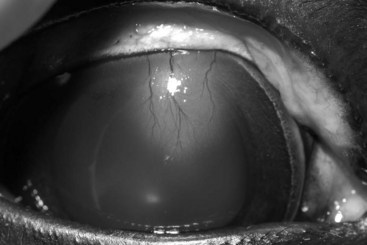Keratitis, Noninfectious
Basic Information 
Definition
Immune-mediated keratitis (IMMK) is one of the most common noninfectious corneal diseases in horses.
Clinical Presentation
Disease Forms/Subtypes
Clinical features of IMMK are based on the depth of the corneal lesion, and four distinct levels have been described. These include epithelial, superficial stromal (45% of cases) (Figure 1), midstromal (27% of cases), and endothelial (23% of cases). With endothelial IMMK, there is commonly focal or diffuse corneal edema and pigment deposition on or at the endothelial surface. Unilateral presentation of IMMK is most common (85%).
Physical Exam Findings
• Diagnosis of IMMK is made if there is a progressive or chronic (>3 mo in duration), nonulcerative, recurrent corneal opacity with or without mild signs of keratitis with cellular infiltrate, corneal vascularization, and ocular discomfort (ie, mild epiphora, slight blepharospasm). Other characteristic features include a lack of secondary uveitis or severe discomfort, a lack of microorganisms, and clinical improvement with antiinflammatory medications.
• Superficial stromal keratitis appears as a diffuse, mild to moderate, yellow to white, cellular infiltrate with diffuse superficial vascularization. Mid or deep stromal cellular infiltrate is less common and appears as diffuse, yellow to white, cellular infiltrate with mild surrounding corneal edema and vascularization. Endotheliitis appears as cellular infiltrate at the endothelium with associated diffuse corneal edema.
< div class='tao-gold-member'>
Stay updated, free articles. Join our Telegram channel

Full access? Get Clinical Tree



